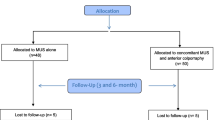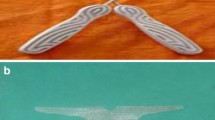Abstract
Introduction and hypothesis
Stress urinary incontinence (SUI) and cystocele often occur concomitantly and thus may potentially be treated via a single surgical procedure. This study evaluated the efficacy and safety of concomitant transobturator tape (TOT) with anterior colporrhaphy versus subvesical transobturator mesh (TOM) for cystocele-associated SUI.
Methods
This prospective, clinical trial included women with cystocele-associated SUI. Patients were randomly allocated into either group I (anterior colporrhaphy with concomitant TOT “in-out” fixation) or group II (implantation of a subvesical four-armed TOM). All patients were followed up at 1, 3, 6, 9, and 12 months postoperatively. Statistical tests were performed to compare the group outcomes based on objective, subjective, and anatomical variables.
Results
There were 81 patients in group I and 83 in group II. Median follow-up duration was 12 months. The demographic data and baseline clinical characteristics of both groups were comparable. There were no significant differences between groups regarding the success rates of SUI and cystocele repair. Groups I and II had similar cure rates of SUI (82.9 and 88.4%, respectively; p = 0.369) and incidences of successful cystocele repair (85.4 and 97.7%, respectively; p = 0.055). No urethral or bladder injuries or mesh erosions were reported. Both groups had comparable postoperative complications, except the greater incidence of micturition difficulty in group I than group II, during the early follow-up (12.2% vs. 0.0%; p = 0.024).
Conclusions
Transvaginal mesh was not superior to native tissue repair. Anterior colporrhaphy and TOT may be an appropriate alternative to four-armed TOM application for concomitant correction of SUI and cystocele.

Similar content being viewed by others
References
Swithinbank LV, Abrams P. The impact of urinary incontinence on the quality of life of women. World J Urol. 1999;17(4):225–9.
Hannestad YS, Rortveit G, Sandvik H, Hunskaar S. A community-based epidemiological survey of female urinary incontinence:: the Norwegian EPINCONT study. J Clin Epidemiol. 2000;53(11):1150–7.
Hunskaar S, Lose G, Sykes D, Voss S. The prevalence of urinary incontinence in women in four European countries. BJU Int. 2004;93(3):324–30.
Leng B, Zhou Y, Du S, Liu F, Zhao L, Sun G, et al. Association between delivery mode and pelvic organ prolapse: a meta-analysis of observational studies. Eur J Obstet Gynecol Reprod Biol. 2019;235:19–25.
Gyhagen M, Bullarbo M, Nielsen T, Milsom I. Prevalence and risk factors for pelvic organ prolapse 20 years after childbirth: a national cohort study in singleton primiparae after vaginal or caesarean delivery. BJOG. 2013;120(2):152–60.
Glazener C, Elders A, Macarthur C, Lancashire R, Herbison P, Hagen S, et al. Childbirth and prolapse: long-term associations with the symptoms and objective measurement of pelvic organ prolapse. BJOG. 2013;120(2):161–8.
Olsen AL, Smith VJ, Bergstrom JO, Colling JC, Clark AL. Epidemiology of surgically managed pelvic organ prolapse and urinary incontinence. Obstet Gynecol. 1997;89(4):501–6.
Serati M, Salvatore S, Uccella S, Artibani W, Novara G, Cardozo L, et al. Surgical treatment for female stress urinary incontinence: what is the gold-standard procedure? Int Urogynecol J. 2009;20(6):619–21.
Maher C, Feiner B, Baessler K, Schmid C. Surgical management of pelvic organ prolapse in women. Cochrane Database Syst Rev. 2013;4:CD004014.
Sergent F, Sentilhes L, Resch B, Verspyck E, Medeiros R, Descamps P, et al. Treatment of concomitant prolapse and stress urinary incontinence via a transobturator subvesical mesh without independent suburethral tape. Acta Obstet Gynecol Scand. 2010;89(2):223–9.
Sharifiaghdas F, Daneshpajooh A, Mirzaei M. Simultaneous treatment of anterior vaginal wall prolapse and stress urinary incontinence by using transobturator four arms polypropylene mesh. Korean J Urol. 2015;56(12):811–6.
de Leval J. Novel surgical technique for the treatment of female stress urinary incontinence: transobturator vaginal tape inside-out. Eur Urol. 2003;44(6):724–30.
De Tayrac R, Brouziyne M, Priou G, Devoldère G, Marie G, Renaudie J. Transvaginal repair of stage III–IV cystocele using a lightweight mesh: safety and 36-month outcome. Int Urogynecol J. 2015;26(8):1147–54.
Yonguc T, Bozkurt IH, Sen V, Aydogdu O, Yonguc GN, Gunlusoy B. Double-sling procedure for the surgical management of stress urinary incontinence with concomitant anterior vaginal wall prolapse. Int Urol Nephrol. 2015;47(10):1611–7.
Karateke A, Tug N, Cam C, Selcuk S, Asoglu MR. Concomitant surgical correction of occult stress urinary incontinence by TOT in patients with pelvic organ prolapse. Eur J Obstet Gynecol Reprod Biol. 2011;154(1):105–7.
Kdous M, Zhioua F. 3-year results of transvaginal cystocele repair with transobturator four-arm mesh: a prospective study of 105 patients. Arab J Urol. 2014;12(4):275–84.
Salvatore S, Soligo M, Meschia M, Luppino G, Piffarotti P, Arcari V. Prosthetic surgery for genital prolapse: functional outcome. Neurourol Urodyn. 2002;21(4):10.
Eboue C, Marcus-Braun N, von Theobald P. Cystocele repair by transobturator four arms mesh: monocentric experience of first 123 patients. Int Urogynecol J. 2010;21(1):85.
Stanford E, Mattox T, Pugh C. Outcomes and complications of transvaginal and abdominal custom-shaped light-weight polypropylene mesh used in repair of pelvic organ prolapse. J Minim Invasive Gynecol. 2011;18(1):64–7.
Finamore PS, Echols KT, Hunter K, Goldstein HB, Holzberg AS, Vakili B. Risk factors for mesh erosion 3 months following vaginal reconstructive surgery using commercial kits vs. fashioned mesh-augmented vaginal repairs. Int Urogynecol J. 2010;21(3):285–91.
Kaufman Y, Singh SS, Alturki H, Lam A. Age and sexual activity are risk factors for mesh exposure following transvaginal mesh repair. Int Urogynecol J. 2011;22(3):307–13.
Elgamasy AK, Elashry OM, Elenin MA, Eltatawy HH, Elsharaby MD. The use of polypropylene mesh as a transobturator sling for the treatment of female stress urinary incontinence (early experience with 40 cases). Int Urogynecol J Pelvic Floor Dysfunct. 2008;19(6):833–8.
Abed H, Rahn DD, Lowenstein L, Balk EM, Clemons JL, Rogers RG, et al. Incidence and management of graft erosion, wound granulation, and dyspareunia following vaginal prolapse repair with graft materials: a systematic review. Int Urogynecol J. 2011;22(7):789–98.
Lucente V, Murphy M, Saiz C. Vaginal prolapse repair: suture repair versus mesh augmentation: a urogynecology perspective. Urol Clin N Am. 2012;39(3):325–33.
Moore RD, Miklos JR. Vaginal repair of cystocele with anterior wall mesh via transobturator route: efficacy and complications with up to 3-year followup. Adv Urol. 2009;2009:743831.
Nieminen K, Hiltunen R, Heiskanen E, Takala T, Niemi K, Merikari M, et al. Symptom resolution and sexual function after anterior vaginal wall repair with or without polypropylene mesh. Int Urogynecol J Pelvic Floor Dysfunct. 2008;19(12):1611–6.
Gauruder-Burmester A, Koutouzidou P, Tunn R. Effect of vaginal polypropylene mesh implants on sexual function. Eur J Obstet Gynecol Reprod Biol. 2009;142(1):76–80.
Vaiyapuri GR, Han HC, Lee LC, Tseng LA, Wong HF. Use of the Gynecare Prolift system in surgery for pelvic organ prolapse: 1-year outcome. Int Urogynecol J. 2011;22(7):869–77.
Hubka P, Masata J, Nanka O, Grim M, Martan A, Zvarova J. Anatomical relationship and fixation of tension-free vaginal tape Secur. Int Urogynecol J Pelvic Floor Dysfunct. 2009;20(6):681–8.
Acknowledgments
We thank Kelly Zammit, BVSc, from Edanz Editing (www.edanzediting.com/ac), for editing a draft of this manuscript.
Author information
Authors and Affiliations
Corresponding author
Ethics declarations
Conflicts of interest
None.
Additional information
Publisher’s note
Springer Nature remains neutral with regard to jurisdictional claims in published maps and institutional affiliations.
Rights and permissions
About this article
Cite this article
Ahmed, AF.A., Abdellatif, A.H., El-Helaly, H.A. et al. Concomitant transobturator tape and anterior colporrhaphy versus transobturator subvesical mesh for cystocele-associated stress urinary incontinence. Int Urogynecol J 31, 1633–1640 (2020). https://doi.org/10.1007/s00192-019-04068-8
Received:
Accepted:
Published:
Issue Date:
DOI: https://doi.org/10.1007/s00192-019-04068-8




